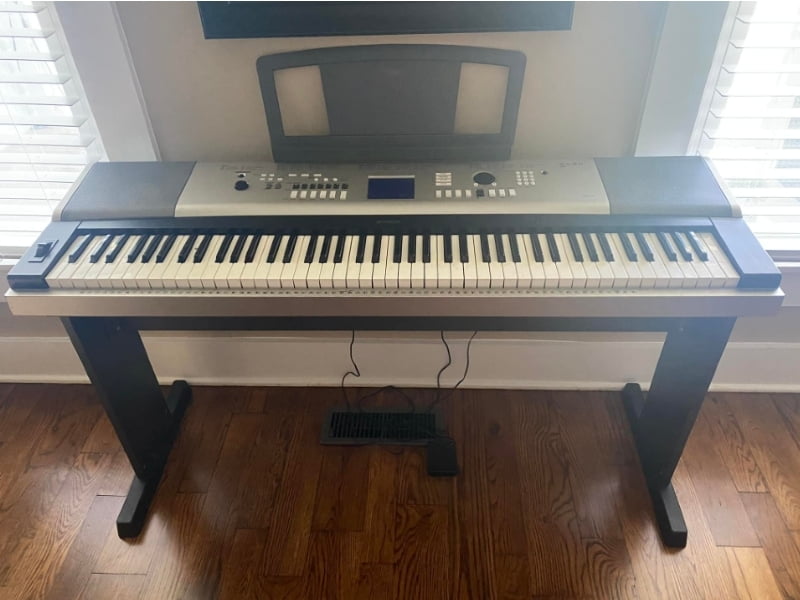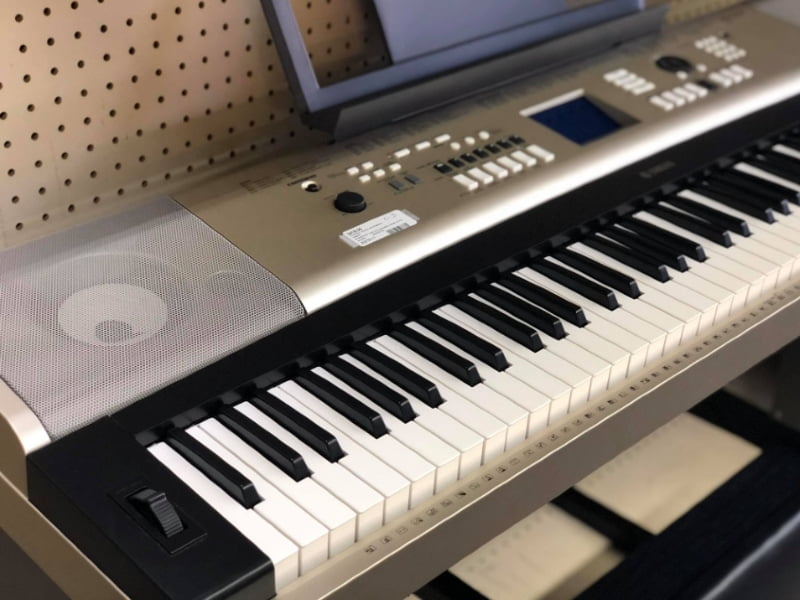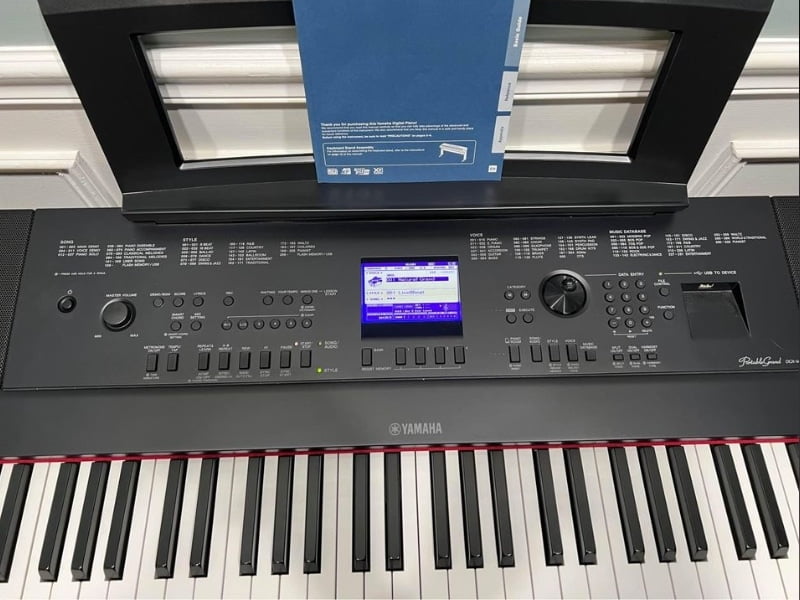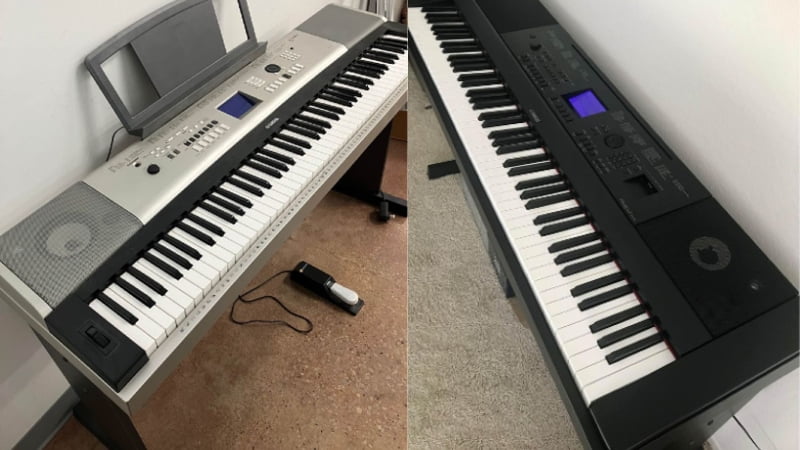In this Yamaha DGX-660 vs YPG-535 comparison, we dive into the features of both pianos to find out which one would be the best pick for you!
Yamaha has a wide array of digital pianos. And two options that recently caught my eye are the DGX-660 and YPG-535. Both of these pianos offer great features for the price, and they are some of the best options in their respective price ranges.
That said, the Yamaha DGX-660 is the more expensive option, and it comes with tons of features to justify the extra cost. With better tones, feel, and polyphony, it easily won this Yamaha DGX-660 vs YPG-535 comparison.
But even if I prefer the DGX-660, not everyone is willing to pay the extra price for all these features. This is why I still think the YPG-535 is a good pick and is worth your time and money.
If you’re splitting hairs when it comes to choosing between these two options, you’ve come to the right place. In this comparison, we’re going through all the differences, features, and similarities between these two pianos. And by the end, you’ll know exactly what to spend your money on.
Yamaha DGX-660 vs YPG-535: Comparison Chart




Last update on 2025-07-09 / Affiliate links / Images from Amazon Product Advertising API
Yamaha DGX-660 vs YPG-535: A Head-to-Head Comparison
There are three main characteristics you want to consider when comparing modern digital pianos – tone, feel, and polyphony. In my experience, these are the features that determine whether or not a piano is good.
The Yamaha DGX-660 won this comparison with a score of 3-0 when using these comparison points. As the more expensive option, this shouldn’t be that much of a surprise. And below, I’ll get into more details on how and why the DGX-660 beat the YPG-535, so keep reading!
Tone
The winner: Yamaha DGX-660
The first thing I checked when I got my hands on these pianos was the tone. You always want to ensure that your digital piano has good tones and a wide selection of them. And between the DGX-660 and the YPG-535, the DGX-660 was the clear winner. Not only does it come with a much more sophisticated tone engine, but it also has a more varied tone library.
+Tone Generation
The YPG-535 uses AWM Stereo Sampling to produce tones. For beginners and those on a budget, this is tone engine is more than decent. It relies on top-quality samples that you trigger when you press a key, and compared to most of the models in its price range; this piano has incredibly crisp and detailed voices.
And while I love the AWM Stereo Sampling Method, it couldn’t compare to the Pure CF Sound Engine on the Yamaha DGX-660. This is one of the brand’s premier tone generators and is one of the sample-based tone engines available.
This is because the Pure CF Sound Engine derives its piano sounds from the Yamaha CF Grand Pianos. This gives you unrivaled brightness and clarity in the tones. On top of that, the non-piano voices also use top-quality samples, giving you a varied library of high-quality tones.

+Sound Library
In its price range, the YPG-535 has one of the widest sound libraries. It has exactly 500 different voices. This sound library contains all the voices you will ever need as a pianist. Whether you want piano, organ, strings, or even drum sounds, this piano has you covered.
That said, the DGX-660 still wins out, but only by a narrow margin. This piano comes with 554 voices, giving you more variety than the YPG-535. And since the DGX-660 also has a better tone engine, it was the easy winner when comparing the tones.
Feel
The winner: Yamaha DGX-660
The next comparison point is the feel. You always want your digital piano to feel close to an acoustic piano. And while neither of these options perfectly replicates the feel of an acoustic instrument, the Yamaha DGX-660 still wins out.
+Hammer Action
The YPG-535 doesn’t come with fully-weighted keys. Instead, it uses a graded soft touch, which is ideal for beginners. This action isn’t as heavy as fully-weighted keys, but you have more resistance on the lower keys compared to the higher keys, like a real acoustic piano.
On the flip side, the Yamaha DGX-660 comes with the Graded Hammer Standard, which is one of the best hammer action systems that Yamaha has to offer. This is because aside from the slight weight differences on the bass and treble keys, you also have the full weight you’d expect from an acoustic piano.
So, if you’re looking for more realism, the Yamaha DGX-660 is the better option. But if you’re a beginner and you want softer keys that are a bit easier to play, then you may want to consider the YPG-535.
The one complaint I had with both pianos was the key texture. This is something that most digital pianos fail at as well, so it wasn’t that big of a surprise. However, if either of these pianos had wooden keys or a coating to replicate the texture of wooden keys, it would have been nice.
I honestly expected the Yamaha DGX-660 to come with wooden keys due to the higher price point. This wasn’t the case, which left me slightly disappointed. But at the end of the day, the DGX-660 still felt more realistic than the YPG-535, which is something that you must note if you’re picking between the two pianos.

Polyphony
The winner: Yamaha DGX-660
The very last feature I chose to compare was polyphony. This is the piano’s ability to play multiple notes at once.
In the past, digital pianos had really low polyphony, which made it hard for pianists to add expression and sustain to their playing. This also limited the playing modes they could install on the piano.
Nowadays, things are a bit different. Technology has come a long way, so most digital pianos come with high maximum polyphony, even if they’re on the more affordable side. For example, the Yamaha DGX-660 has 192-note maximum polyphony. This allows you to play all the piano notes at once and even have the sustain pedal on while expecting great clarity.
When researching the YPG-535, I was very disappointed with the polyphony. It only comes with 32-note polyphony, which limits your possibilities as a pianist. This won’t be that big of a deal if you’re a beginner, as you won’t need to play that many simultaneous notes in the first place.
However, if you’re an advanced pianist, you will feel the limitations of this polyphony. This is why I would highly recommend the DGX-660 over the YPG-535. Even if you’re a beginner, you might want to go for the DGX-660 so you won’t have to consider changing pianos later on if you need higher polyphony.

Yamaha DGX-660 vs YPG-535: The Similarities
One of the things that made this comparison really interesting was that they are very different. They are designed for different pianists, fall in different price ranges, and come with their own distinct features. However, even with all those differences, I was still able to find a few similarities.
For example, both pianos come with dual modes. This allows you to blend two voices together and create unique combinations that are your own. Whether you’re a beginner or an advanced pianist, this is a cool feature that will definitely come in handy when you dive into other musical styles.
On top of that, both of these pianos are portable. Nowadays, investing in a portable digital piano is a much better option than a console instrument as it gives you much more flexibility. So, if you need a piano for home practice, lessons, or even gigs, either piano would be ideal.
But again, the Yamaha DGX-660 is far more flexible, has better tones, and feels more realistic. Between these two instruments, the DGX-660 was obviously the better option. So, if you’re willing to spend a bit more on a piano that will last you much longer, you’re better off with the DGX-660.
Quick Rundown of the Yamaha DGX-660
- The Pure CF Sound Engine faithfully reproduces the tone of a meticulously sampled and highly acclaimed Yamaha concert grand piano
- GHS weighted action is heavier in the low register and lighter in the high, just like an acoustic piano
- Score display puts music notation of MIDI songs on the screen, helping you play your favorites by following the bouncing ball
- The Piano room lets you choose from a variety of pianos and acoustic settings to create your own personal piano environment
- The 6 track recorder allows you to capture your performances and song ideas, then add additional layers to spice up your pieces
Last update on 2025-07-09 / Affiliate links / Images from Amazon Product Advertising API
Quick Rundown of the Yamaha YPG-535
- Your purchase includes One Yamaha Portable Grand Piano, YPG535 model | Music Rest, Power Supply (PA-150), Sustain Pedal (FC5), Owner’s Manual and CD-ROM
- Piano dimensions (with stand) – 53-1/3” W x 30-1/2” H x 19-1/8” | Weight (with stand) – 37 lbs. | Display Size – 320 x 240 dots
- Specifications: Headphones – 1 | Sustain Pedal – 1 | USB to device | USB to host | Reverb – 9 types | Chorus – 4 types | Master EQ – 5 types
- Yamaha Portable Grand comes with 30 built-in songs plus 70 more on an included CD-ROM and an interactive lesson system, divided into left and right hand parts, for learning them
- Keyboard is not weighted. Easy-to-use panel, a wealth of piano-centric features including piano-style keys, Graded Soft Touch (GST) action with different levels of resistance and a high-resolution stereo piano sample
Last update on 2025-07-09 / Affiliate links / Images from Amazon Product Advertising API
Product Video
Related Articles to Yamaha Dgx 660
- Yamaha YDP-164 vs DGX-660: Why You Should Go for the DGX-660
- Yamaha DGX-660 vs Roland FP-90: Why the Roland FP-90 Is the Better Pick
- Yamaha DGX-530 vs 660: Why the DGX-660 Is the Better Pick
- Yamaha DGX-505 vs 660: Why the DGX-660 Is the Better Pick
- Yamaha DGX-660 vs DGX-640: A DGX Comparison
- Yamaha DGX-660 vs DGX-630: A DGX Comparison
- Yamaha DGX-620 vs 660: Finding the Best DGX Model
- Yamaha DGX-660 vs YDP-163: Which Is the Better Piano?
- Yamaha DGX-660 vs Roland Juno DS-88: Which Is the Better Piano?
- Yamaha DGX-660 vs Casio PX-360: Which Is the Better Piano?
- Yamaha DGX-660 vs YDP-144: Which Is the Better Yamaha Piano?
- Yamaha DGX-660 vs Korg Havian 30: Which Is the Better Digital Piano?
- Yamaha DGX-660 vs Casio CGP-700: Which Is the Better Pick?
- Yamaha DGX-660 vs P515: Is the P515 Worth the Extra Cost?
- Yamaha DGX-660 vs P-115: Which Yamaha Model Is Better?
- Yamaha DGX-660 vs Casio PX-560: Which Piano Offers More Value For The Money
- Yamaha DGX-660 vs 650: A DGX Comparison
- Korg XE-20 vs Yamaha DGX-660: Finding the Best Digital Piano
- Yamaha P45 Vs DGX-660: A Head-to-Head Comparison
- Yamaha DGX 670 Vs 660: The Distinct Difference In Details You Need To Know About
- Yamaha YDP-103 Vs DGX-660: Which Is The Better Yamaha Piano?
- Casio PX-770 Vs Yamaha DGX-660: Should You Get A Portable Or Console Digital Piano?
- Yamaha P71 vs DGX-660: Can the Amazon Exclusive Beat Out the Premium Model?
- Yamaha P125 vs DGX 660 Comparison: Can the P125 Hold Its Own Against the DGX 660?
Related Articles to Yamaha Ypg 535
References:
- Yamaha DGX-660: https://usa.yamaha.com/products/musical_instruments/pianos/p_series/dgx-660/specs.html
- Yamaha YPG-535: https://usa.yamaha.com/products/musical_instruments/pianos/p_series/ypg-535/specs.html
Lulacruza is an electronic folk duo operating at the junction of the hypermodern and the ancient. Our music weaves together hypnotic female singing, South American folk instruments and electronic processing, while channeling pulsating waves from the source of creation.
Lalucruza is also a community where you can connect with other music lovers to collaborate, exchange ideas and share knowledge. A platform for who wants to learns the basics of playing piano, guitar, drum masters’ technique, etc.. is the premise of our website.
